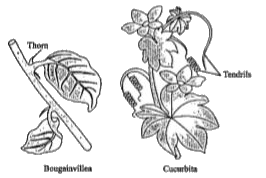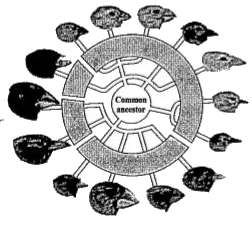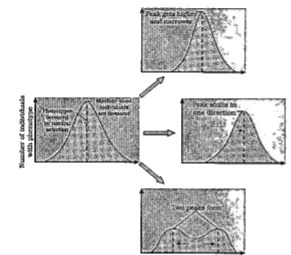MATCH from SRIJAN BIOLOGY (ENGLISH) EVOLUTION for Class 12
| Class 12 | BIOLOGY |
| Chapter | EVOLUTION |
| SRIJAN BIOLOGY (ENGLISH) | MATCH |
| Medium | English |
| Academic Year | 2023-2024 |
Question 54
The ............... A ....... from the sun broke up water into hydrogen and oxygen and the .......... B ............ escaped. Oxygen combined with ammonia and methane to form ............... C ..............., CO2, and others. The ozone layer was formed. As it cooled, the water vapour fell as rain, to fill all the depressions and form ...............D.............. View SolutionQuestion 55
When migration of a section of population to another place and population occurs, ............. A.... .............. change in the original as well as in the new population. New genes/alleles are added to the ................B................. population and these are lost from the ...............C................. population: There would be a .............. D................ if this gene migration, happens multiple times. If the same change occurs by chance, it is called ............ E ................View SolutionQuestion 75
Read the passages and answer the questions that follow:
Mutation is a driving force of evolution that involves random change in an organism's genetic makeup, and influences the population's gene pool. It is a change in the nature of the DNA in one or more chromosomes. Mutations give rise to new alleles, therefore, they are a source of genetic variation in a population
Mutations may be harmful or benign, but they may also be beneficial. For example, a mutation may permit organisms in a population to produce enzymes that will allow them to use certain food materials. Whether or not a mutation is beneficial or harmful is determined by whether it helps an organism survive to sexual maturity and reproduce. Over time, these types of individuals survive, while those that don't have the mutations are more likely to perish. Therefore, natural selection tends to remove the less-fit individuals, allowing more-fit individuals to survive and form a population.
Hugo de Vries did an experiment on which plant to prove mutation theory?View SolutionQuestion 76
Read the passages and answer the questions that follow:
Mutation is a driving force of evolution that involves random change in an organism's genetic makeup, and influences the population's gene pool. It is a change in the nature of the DNA in one or more chromosomes. Mutations give rise to new alleles, therefore, they are a source of genetic variation in a population
Mutations may be harmful or benign, but they may also be beneficial. For example, a mutation may permit organisms in a population to produce enzymes that will allow them to use certain food materials. Whether or not a mutation is beneficial or harmful is determined by whether it helps an organism survive to sexual maturity and reproduce. Over time, these types of individuals survive, while those that don't have the mutations are more likely to perish. Therefore, natural selection tends to remove the less-fit individuals, allowing more-fit individuals to survive and form a population.
Which of the following does not belong to Mutation theory?View SolutionQuestion 77
Read the passages and answer the questions that follow:
Mutation is a driving force of evolution that involves random change in an organism's genetic makeup, and influences the population's gene pool. It is a change in the nature of the DNA in one or more chromosomes. Mutations give rise to new alleles, therefore, they are a source of genetic variation in a population
Mutations may be harmful or benign, but they may also be beneficial. For example, a mutation may permit organisms in a population to produce enzymes that will allow them to use certain food materials. Whether or not a mutation is beneficial or harmful is determined by whether it helps an organism survive to sexual maturity and reproduce. Over time, these types of individuals survive, while those that don't have the mutations are more likely to perish. Therefore, natural selection tends to remove the less-fit individuals, allowing more-fit individuals to survive and form a population.
For evolutionary success mutation must occur in: View SolutionQuestion 78
Read the passages and answer the questions that follow:
Mutation is a driving force of evolution that involves random change in an organism's genetic makeup, and influences the population's gene pool. It is a change in the nature of the DNA in one or more chromosomes. Mutations give rise to new alleles, therefore, they are a source of genetic variation in a population
Mutations may be harmful or benign, but they may also be beneficial. For example, a mutation may permit organisms in a population to produce enzymes that will allow them to use certain food materials. Whether or not a mutation is beneficial or harmful is determined by whether it helps an organism survive to sexual maturity and reproduce. Over time, these types of individuals survive, while those that don't have the mutations are more likely to perish. Therefore, natural selection tends to remove the less-fit individuals, allowing more-fit individuals to survive and form a population.
Sudden heritable changes are called: View SolutionQuestion 79
Read the passages and answer the questions that follow:
Mutation is a driving force of evolution that involves random change in an organism's genetic makeup, and influences the population's gene pool. It is a change in the nature of the DNA in one or more chromosomes. Mutations give rise to new alleles, therefore, they are a source of genetic variation in a population
Mutations may be harmful or benign, but they may also be beneficial. For example, a mutation may permit organisms in a population to produce enzymes that will allow them to use certain food materials. Whether or not a mutation is beneficial or harmful is determined by whether it helps an organism survive to sexual maturity and reproduce. Over time, these types of individuals survive, while those that don't have the mutations are more likely to perish. Therefore, natural selection tends to remove the less-fit individuals, allowing more-fit individuals to survive and form a population.
Which of the following point favour mutation theory?View SolutionQuestion 80
Evolution is the change in heritable traits of biological populations over successive generations. Evolutionary processes give rise to diversity at every biological organization level. All life on earth shares a common ancestor known as the last universal ancestor. In the mid-19th century, Charles Darwin formulated the scientific theory of evolution by natural selection, while in the early 20th century the modern evolutionary synthesis integrated classical genetics with Darwin's theory of evolution by natural selection through the discipline of population genetics.
The Origin of Species was written by .............View SolutionQuestion 81
Evolution is the change in heritable traits of biological populations over successive generations. Evolutionary processes give rise to diversity at every biological organization level. All life on earth shares a common ancestor known as the last universal ancestor. In the mid-19th century, Charles Darwin formulated the scientific theory of evolution by natural selection, while in the early 20th century the modern evolutionary synthesis integrated classical genetics with Darwin's theory of evolution by natural selection through the discipline of population genetics.
The force that initiates evolution is ...... View SolutionQuestion 82
Evolution is the change in heritable traits of biological populations over successive generations. Evolutionary processes give rise to diversity at every biological organization level. All life on earth shares a common ancestor known as the last universal ancestor. In the mid-19th century, Charles Darwin formulated the scientific theory of evolution by natural selection, while in the early 20th century the modern evolutionary synthesis integrated classical genetics with Darwin's theory of evolution by natural selection through the discipline of population genetics.
Change of frequency of alleles in a population results in evolution. This statement is proposed in: View SolutionQuestion 83
Evolution is the change in heritable traits of biological populations over successive generations. Evolutionary processes give rise to diversity at every biological organization level. All life on earth shares a common ancestor known as the last universal ancestor. In the mid-19th century, Charles Darwin formulated the scientific theory of evolution by natural selection, while in the early 20th century the modern evolutionary synthesis integrated classical genetics with Darwin's theory of evolution by natural selection through the discipline of population genetics.
Theory of inheritance of acquired characters was given by:View SolutionQuestion 84
Evolution is the change in heritable traits of biological populations over successive generations. Evolutionary processes give rise to diversity at every biological organization level. All life on earth shares a common ancestor known as the last universal ancestor. In the mid-19th century, Charles Darwin formulated the scientific theory of evolution by natural selection, while in the early 20th century the modern evolutionary synthesis integrated classical genetics with Darwin's theory of evolution by natural selection through the discipline of population genetics.
The earliest geological time period among the following is .....View SolutionQuestion 85
Comparative anatomy is the study of the similarities and differences in the structures of different species. Similar body parts may be homologies or analogies. Both provide evidence for evolution. Just as Darwin did many years ago, today's scientists study living species to learn about evolution. They compare the anatomy, embryos, and DNA of modern organisms to understand how they evolved. In the case of phylogeny, evolutionary investigations focus on two types of evidence: morphologic (form and function) and genetic. In general, organisms that share similar physical features and genomes tend to be more closely related than those that do not.
Example of a homologous organ: View SolutionQuestion 86
Comparative anatomy is the study of the similarities and differences in the structures of different species. Similar body parts may be homologies or analogies. Both provide evidence for evolution. Just as Darwin did many years ago, today's scientists study living species to learn about evolution. They compare the anatomy, embryos, and DNA of modern organisms to understand how they evolved. In the case of phylogeny, evolutionary investigations focus on two types of evidence: morphologic (form and function) and genetic. In general, organisms that share similar physical features and genomes tend to be more closely related than those that do not.
Homologous organs indicate: View SolutionQuestion 87
Comparative anatomy is the study of the similarities and differences in the structures of different species. Similar body parts may be homologies or analogies. Both provide evidence for evolution. Just as Darwin did many years ago, today's scientists study living species to learn about evolution. They compare the anatomy, embryos, and DNA of modern organisms to understand how they evolved. In the case of phylogeny, evolutionary investigations focus on two types of evidence: morphologic (form and function) and genetic. In general, organisms that share similar physical features and genomes tend to be more closely related than those that do not.
An example of convergent evolution is: View SolutionQuestion 88
Comparative anatomy is the study of the similarities and differences in the structures of different species. Similar body parts may be homologies or analogies. Both provide evidence for evolution. Just as Darwin did many years ago, today's scientists study living species to learn about evolution. They compare the anatomy, embryos, and DNA of modern organisms to understand how they evolved. In the case of phylogeny, evolutionary investigations focus on two types of evidence: morphologic (form and function) and genetic. In general, organisms that share similar physical features and genomes tend to be more closely related than those that do not.
Analogous organs arise due to: View SolutionQuestion 89
Comparative anatomy is the study of the similarities and differences in the structures of different species. Similar body parts may be homologies or analogies. Both provide evidence for evolution. Just as Darwin did many years ago, today's scientists study living species to learn about evolution. They compare the anatomy, embryos, and DNA of modern organisms to understand how they evolved. In the case of phylogeny, evolutionary investigations focus on two types of evidence: morphologic (form and function) and genetic. In general, organisms that share similar physical features and genomes tend to be more closely related than those that do not.
Identify the examples of convergent evolution from the following:View SolutionQuestion 90
Hardy - Weinberg Principle mathematically explains the occurrence and consistency of gene frequency for a particular gene. The principle states that the allelic frequency remains constant through generations and the gene pool remains constant. This phenomenon is called genetic equilibrium. Various factors contribute to the change in gene frequency of a species in an area. If a few individuals from a species migrate to another place, the gene frequency changes again. It decreases from the place from where the individuals migrate and increase in the place they migrate to. If the frequency of the genes is high enough in the newly migrated land to start a new species, the migrated individuals become the founder species, and the effect is called the founder effect. Thus, it contributes to the process of evolution.
Which of the following represents the Hardy Weinberg equation?View SolutionQuestion 91
Hardy - Weinberg Principle mathematically explains the occurrence and consistency of gene frequency for a particular gene. The principle states that the allelic frequency remains constant through generations and the gene pool remains constant. This phenomenon is called genetic equilibrium. Various factors contribute to the change in gene frequency of a species in an area. If a few individuals from a species migrate to another place, the gene frequency changes again. It decreases from the place from where the individuals migrate and increase in the place they migrate to. If the frequency of the genes is high enough in the newly migrated land to start a new species, the migrated individuals become the founder species, and the effect is called the founder effect. Thus, it contributes to the process of evolution.
The notation p and of the Hardy Weinberg equation represent ................... of a diploid organism.View SolutionQuestion 92
Hardy - Weinberg Principle mathematically explains the occurrence and consistency of gene frequency for a particular gene. The principle states that the allelic frequency remains constant through generations and the gene pool remains constant. This phenomenon is called genetic equilibrium. Various factors contribute to the change in gene frequency of a species in an area. If a few individuals from a species migrate to another place, the gene frequency changes again. It decreases from the place from where the individuals migrate and increase in the place they migrate to. If the frequency of the genes is high enough in the newly migrated land to start a new species, the migrated individuals become the founder species, and the effect is called the founder effect. Thus, it contributes to the process of evolution.
.................. was the island where Darwin visited and discovered adaptive radiation?View SolutionQuestion 93
Hardy - Weinberg Principle mathematically explains the occurrence and consistency of gene frequency for a particular gene. The principle states that the allelic frequency remains constant through generations and the gene pool remains constant. This phenomenon is called genetic equilibrium. Various factors contribute to the change in gene frequency of a species in an area. If a few individuals from a species migrate to another place, the gene frequency changes again. It decreases from the place from where the individuals migrate and increase in the place they migrate to. If the frequency of the genes is high enough in the newly migrated land to start a new species, the migrated individuals become the founder species, and the effect is called the founder effect. Thus, it contributes to the process of evolution.
Which of the following does not belong to the Hardy Weinberg principle?View SolutionQuestion 94
Hardy - Weinberg Principle mathematically explains the occurrence and consistency of gene frequency for a particular gene. The principle states that the allelic frequency remains constant through generations and the gene pool remains constant. This phenomenon is called genetic equilibrium. Various factors contribute to the change in gene frequency of a species in an area. If a few individuals from a species migrate to another place, the gene frequency changes again. It decreases from the place from where the individuals migrate and increase in the place they migrate to. If the frequency of the genes is high enough in the newly migrated land to start a new species, the migrated individuals become the founder species, and the effect is called the founder effect. Thus, it contributes to the process of evolution.
It is known that the total sum of all the frequencies of the allele is ....View Solution
All Exercises from SRIJAN BIOLOGY (ENGLISH) Class 12 BIOLOGY EVOLUTION
- ASSERTION AND REASON
- CHOOSE THE ODD ONE OUT
- FIGURE BASED
- FILL IN THE BLANKS
- ILLUSTRATIVE QUESTIONS
- MATCH
- MULTIPLE CHOICE QUESTIONS
- NUMERICALS
- SOURCE BASED
- PRACTICE QUESTIONS (LONG ANSWER TYPE QUESTIONS)
- PRACTICE QUESTIONS (SHORT ANSWER TYPE-I QUESTIONS)
- PRACTICE QUESTIONS (SHORT ANSWER TYPE-II QUESTIONS)
- PRACTICE QUESTIONS (VERY SHORT ANSWER TYPE QUESTIONS)
- PREVIOUS YEAR.S BOARD PAPER QUESTIONS ( VERY SHORT ANSWER TYPE QUESTIONS)
- PREVIOUS YEAR.S BOARD PAPER QUESTIONS (LONG ANSWER TYPE QUESTIONS)
- PREVIOUS YEAR.S BOARD PAPER QUESTIONS (SHORT ANSWER TYPE-L QUESTIONS)
- PREVIOUS YEAR.S BOARD PAPER QUESTIONS (SHORT ANSWER TYPE-LI QUESTIONS)
- REVIEW QUESTIONS
- COMPETITION CORNER (ASSERTION AND REASON TYPE QUESTIONS (FOR AIIMS ASPIRANTS))
- COMPETITION CORNER (OBJECTIVE TYPE QUESTIONS) (MULTIPLE CHOICE QUESTIONS (MCQS))






